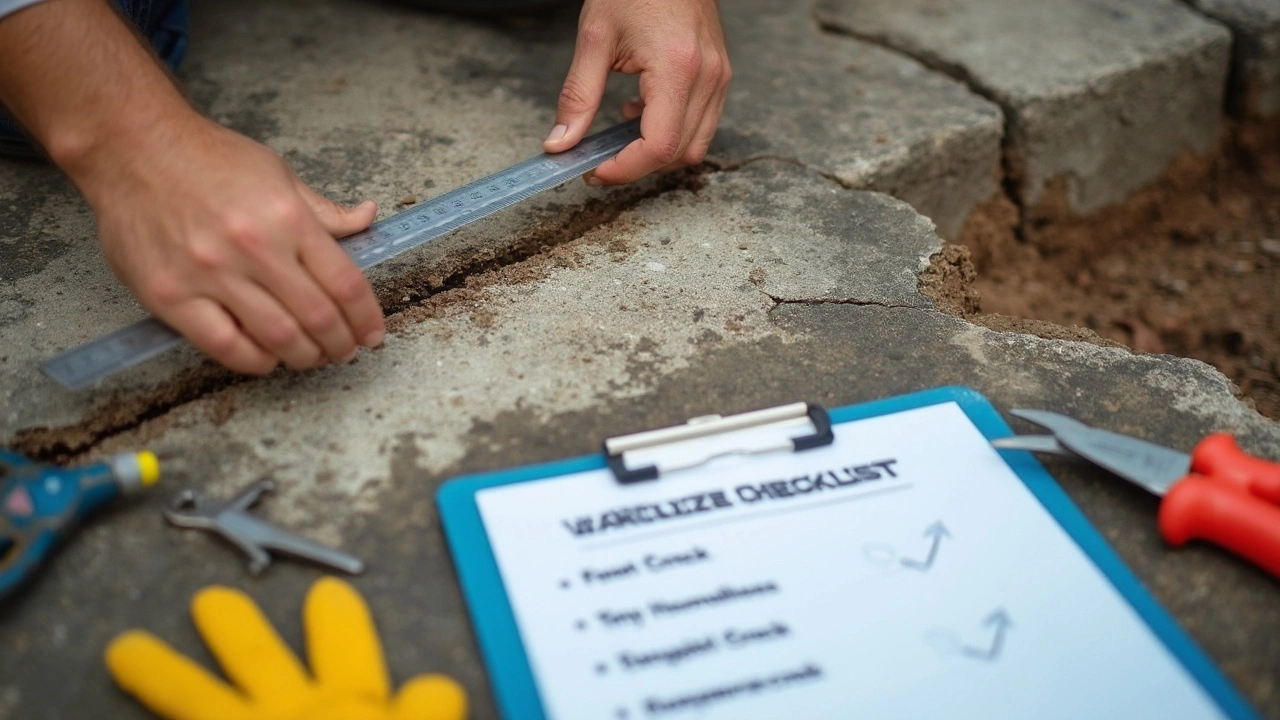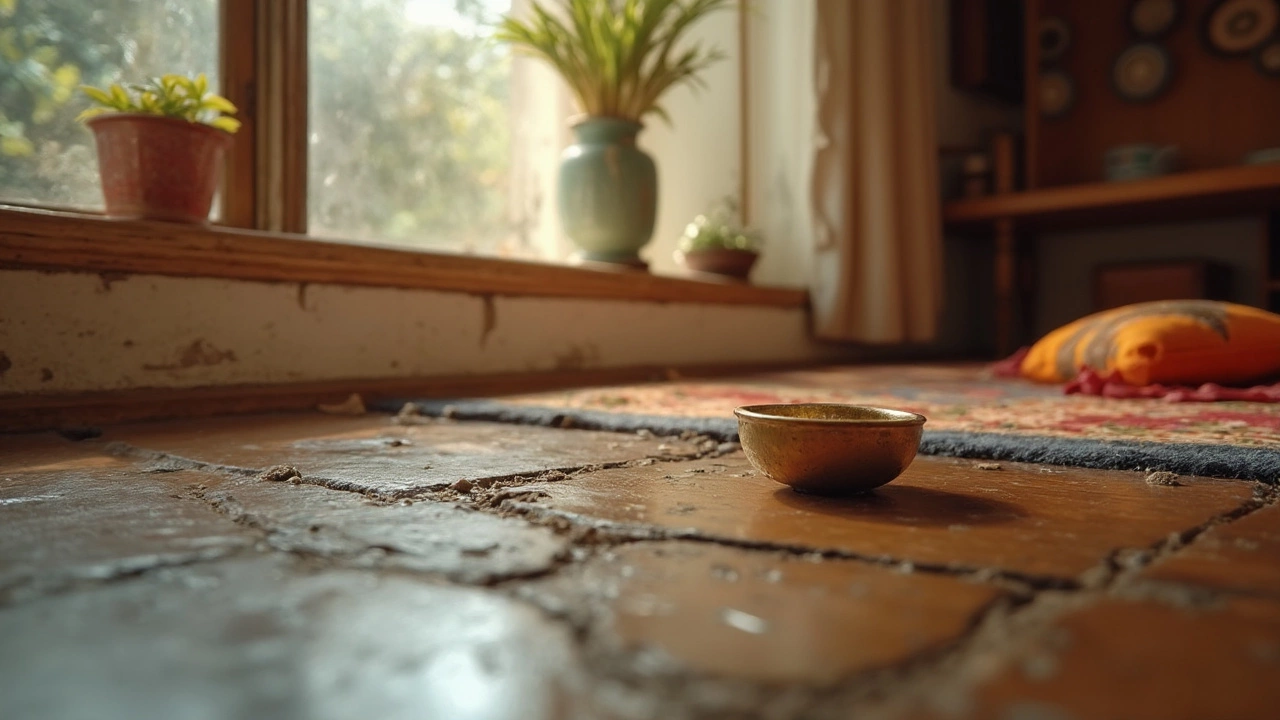Foundation Crack Size: What’s Actually Okay?

Spotting a crack in your foundation can set off alarm bells, but not all cracks are a big deal. Some are normal and just part of a house settling. Others might mean costly repairs are coming—so knowing the difference can save you a ton of stress (and money).
The big question: how wide is too wide? If your crack is less than 1/8 of an inch—about the width of a nickel—it's usually not urgent. Hairline cracks pop up as concrete shrinks and dries, and most of the time, they stay put. But if the crack is wider than 1/4 inch, or you can fit a pencil tip inside, that's a different story. Wider cracks could mean ongoing movement, which is definitely something to watch.
Length matters too. A short crack in just one spot is very different than a long one running across the whole wall or floor. And keep an eye on whether the crack changes over time. If it starts small and keeps growing, you don’t want to ignore it.
- Common Types of Foundation Cracks
- What Size Crack Is a Red Flag?
- Why Cracks Happen and What They Mean
- DIY Fix or Professional Repair?
Common Types of Foundation Cracks
Not all cracks in a foundation are the same. The kind of crack you spot makes a big difference in figuring out what’s going on—and what you need to do next. Most cracks fall into a few categories, and each tells its own story about your house.
- Vertical Cracks: These are the most common. They usually run straight up and down (or close to it). Most of the time, vertical cracks show up as the concrete shrinks after being poured. If they’re less than 1/8 inch wide, they’re mostly harmless and usually not a sign of structural trouble.
- Diagonal/Angled Cracks: These cracks typically run at a 30 to 75-degree angle. If you see them near the corners of your foundation, it could mean uneven settling or shifting soils. It’s smart to keep a close eye on these because they sometimes point to a bigger issue.
- Horizontal Cracks: These are the ones to worry about. Horizontal cracks—especially in basement walls—can be caused by pressure from outside the foundation, like water buildup in the soil (known as hydrostatic pressure). These need attention right away, and you’ll probably want a professional to check them out.
- Stair-Step Cracks: These show up in concrete block or brick foundations and look like steps climbing up the wall. Small stair-step cracks can come from normal settling, but wider ones often mean shifting or bowing walls, especially if they run the whole wall length.
Here’s a quick breakdown of what different cracks often mean and how common they are:
| Crack Type | Common Cause | How Serious? | % of Cases |
|---|---|---|---|
| Vertical | Concrete shrinkage, settling | Usually minor | 45% |
| Diagonal | Soil movement, foundation shift | Sometimes serious | 25% |
| Horizontal | Soil pressure, water buildup | Often serious | 12% |
| Stair-step | Settling, wall movement | Can be serious | 18% |
If you spot a new crack, snap a photo and measure the width. That way, you’ll have a record if things change. No one wants surprise repairs, so knowing your foundation crack size and type helps you react fast and smart.
What Size Crack Is a Red Flag?
Not all cracks are the same, but some clearly fall into the danger zone. The big thing pros look at is foundation crack size—and when it gets over a certain width, you should pay attention. Cracks less than 1/8 inch thick (about the width of a quarter) are pretty common. Once a crack hits 1/4 inch or more, though, it’s a possible red flag. These wider cracks often mean a bigger shift is happening underneath your home.
Want to keep it simple? If you can press the tip of a standard pencil into the crack, it’s time to start worrying. Anything wider than that, or cracks that keep getting bigger, could point to real movement under your slab or basement wall.
Here’s a quick breakdown you can use for measuring cracks:
| Crack Width | Risk Level | Action |
|---|---|---|
| Less than 1/16 inch | Low | Monitor; usually safe |
| 1/16 – 1/8 inch | Medium | Document and watch for changes |
| 1/8 – 1/4 inch | Concerning | Get a pro to check it out |
| More than 1/4 inch | High | Repair likely needed |
But it’s not just the width. If a crack is jagged, steps up or down, or has water seeping through, it needs fast attention. Vertical cracks are less scary than horizontal or stair-step cracks, which can mean your wall is bowing or your ground is moving. Horizontal cracks wider than 1/8 inch? Get them checked ASAP; those can lead straight to wall failure if ignored.
If you spot new or growing wide cracks—especially if doors start sticking or floors get weirdly uneven—you might have a bigger problem. Tracking crack size with a ruler or snapping a quick photo once a month is a smart move, so you can spot changes before it gets expensive.

Why Cracks Happen and What They Mean
Cracks in your foundation aren’t always a sign of disaster. Concrete naturally wants to shrink as it cures, which is why those little hairline cracks often show up within the first year of building. If these cracks don’t widen or start leaking, you probably don’t need to worry much.
Soil movement under and around your house is another big factor. When the ground gets soaked after a heavy rain, clay soils expand. During dry stretches, they shrink back down. This movement puts pressure on slab or basement walls, and sometimes cracks form. In some areas—especially places with lots of clay—it’s almost impossible to avoid.
Temperature swings can also mess with concrete. When it heats up and cools down, concrete expands and contracts. Over time, this pushes and pulls at the foundation. If you see a pattern of cracks near windows, doors, or corners, temperature changes could be the cause.
Sometimes, cracks mean trouble. If you see horizontal cracks, stair-step cracks in brick, or any cracking paired with sticking doors, windows, or sloping floors, pay attention. This can mean serious shifting, often from water pooling around the foundation or tree roots pulling moisture out of the soil.
- If water leaks through the crack, it could invite mold or damage inside your home.
- Vertical cracks are usually less serious than horizontal ones—vertical often means settling, horizontal often suggests outside pressure.
- If you spot a crack wider than 1/4 inch, or one that keeps growing, that’s usually a sign to get a pro involved for a closer look.
The most important thing: don’t just ignore those foundation crack size questions. Keep an eye out, take notes, and know what each type typically signals. Catching a problem early always beats waiting until it’s a giant headache.
DIY Fix or Professional Repair?
When it comes to cracks in your foundation, figuring out what you can handle on your own and when to call in the pros isn’t always obvious. But getting this wrong can mean wasting money or, worse, risking your home’s safety. Let’s get clear about who should fix what.
If you spot hairline cracks or something under 1/8 of an inch, you can usually tackle it yourself. Hardware stores sell crack repair kits—usually epoxy or polyurethane foam. Here’s how a simple DIY fix goes:
- Clean out the crack with a wire brush and vacuum away dust.
- Mix up the repair kit components as instructed.
- Squeeze the epoxy or foam into the crack.
- Let it cure as directed, then check in a few days to make sure the crack isn’t growing.
If your crack fits the “pencil tip” test or is wider than a nickel (more than 1/4 inch), or if it’s growing, it’s time to call a foundation specialist. Wide, shifting cracks can signal serious movement or water problems—not a weekend job. Foundation pros use special tools to find out if the crack is just cosmetic or if there’s hidden damage. They might use carbon fiber stitching, wall anchors, or even pier systems if things look bad.
Also, any vertical cracks leaking water and any horizontal cracks bigger than 1/8 inch really need a pro’s eyes. These can lead to serious issues fast—think mold, flooding, or a wall starting to bow in. Even if a small crack is leaking after rain, it’s smart to get a pro’s advice.
Most importantly, don’t just cover up a foundation crack size issue. If a crack keeps coming back or gets bigger, it’s a sign your house is still shifting. That’s not a job for a tube of epoxy. Picking the right fix early can keep costs down and your house sturdy for years to come.


